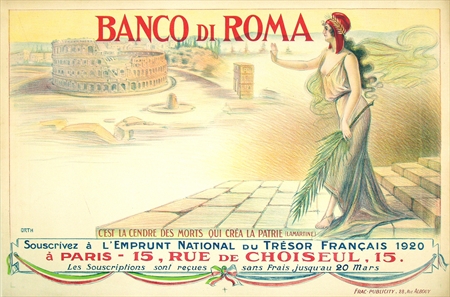Sneak Peek! New Acquisitions in Shop this Weekend.
August 18, 2016 § 1 Comment

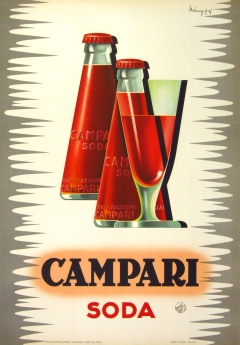
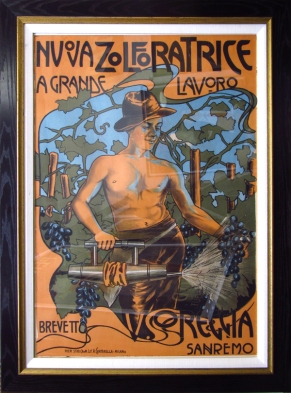
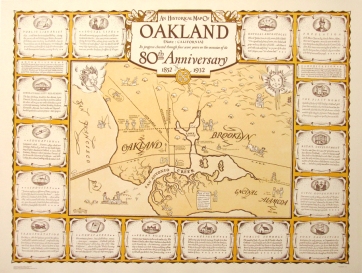
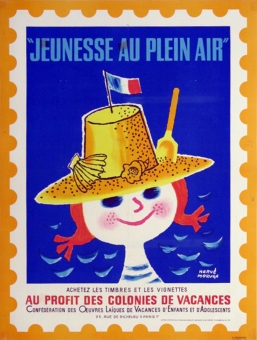
Air France: French West Africa and Extrême Orient
August 14, 2016 § Leave a comment
After World War Two commercial air travel was, for the first time accessible to the public. Wartime technological advancements including radar and improvements in engineering led to faster, safer, and larger planes. An adventurous traveler could now leave their continent and in less than a day find themselves on the other side of the globe. Travel posters, always a tool of mass communication, showed exotic destinations as a means of announcing, “The world is now open to all.” Air France, one of the preeminent airlines both before and after WWII, employed the poster expertly. Their routes traced a history of commerce and many were carved out through colonialism. It is interesting to look at Air France’s choices of which destinations to promote to tourists in their advertising posters and also to examine the images used to evoke adventure, exoticism and ownership.
Although the war afforded advancements in technology and global economics, other institutions, like colonialism, persisted. Many European countries held stake in colonies thousands of miles apart. The British Empire’s holdings in India, the Middle East, and East Africa are often at the forefront of people’s minds, however, France and even smaller nations like Belgium and Portugal were key colonial players. France held power in North and West Africa as well as Vietnam, Laos, Cambodia, and the Caribbean.
***
Of the Allied powers, the French suffered particular hardship during WWII. As a Nazi occupied nation and one situated on the front lines, France’s infrastructure and economy were decimated by the end of war. Despite this, companies like Air France thrived in the new postwar environment. Flights around France, Europe, and the French colonies in Africa, Asia, and the Caribbean became increasingly popular. France’s colonial presences in West Africa and the Far East or L’Extrême Orient, especially Vietnam, made travel to these locations seem exotic yet possible. Posters, like the ones below, were created to market these destinations. The posters themselves, very similar in subject matter, speak to the ethos of the time.
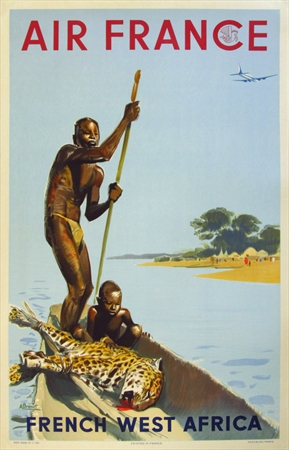
The West Africa poster was created in 1949 by Albert Brenet and shows two young men in a West African pirogue with their prey. This striking image makes references to the exotic bounty of the colony and would have grabbed the attention of any passer by.
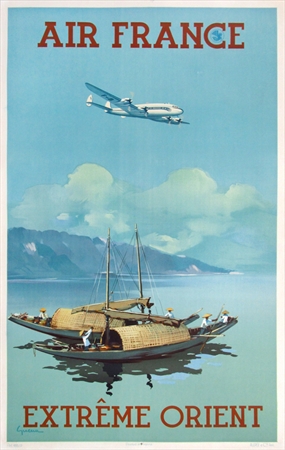
Extrême Orient by Vincent Guerra, was printed in in 1950 and features a beautiful bay and mountain scene with fishermen in their woven topped junks. The prominence of the plane shows France’s ownership of this scene as if to say “It’s ours- come explore it.” Both of these images seem to symbolize a rural, bucolic lifestyle that wasn’t quite the reality (pg. 130 Air France, https://www.scribd.com/document/54130846/The-Junk-Blue-Book). The Vietnam of the 1950s was fully embroiled in a war for its independence, first from the Japanese, then the French, culminating in the Vietnam War.
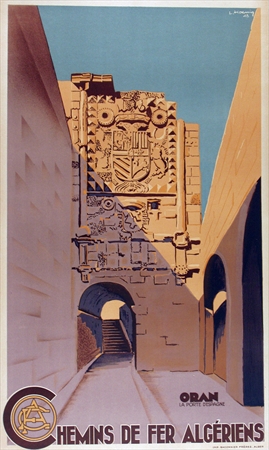
West Africa suffered similar hardships at the hand of its colonial rulers. While embroiled in bureaucratic struggles for recognition by the French Government, the native peoples of these West African nations, (Sénégal, Mali, Côte D’Ivoire, Burkina Faso, Mauritania, French Guinea, Benin, and Niger) were treated as subjects not citizens. Independence came in March of 1962 after the bloody Algerian War.
Today the colonial references on these posters are so obvious as to be almost embarrassing to the Western viewer. But they are an indelible record of the prevailing attitudes of the time period, as are all advertising posters. It’s important that they be preserved so that their messages are not forgotten.
This post was written by Susannah Starr, Summer Intern and Elizabeth Norris, Proprietor of Vintage European Posters.
Established 1997
Member IVPDA
Our Shop: 2201 Fourth Street, Berkeley Corner of Allston Way
Summer Hours Tuesday- Thursday 11-5
and select weekends
Also available by appointment
Please call 510 843 2201 or email vintageposters@vepca.com to confirm hours.
Visit our collection on the web at vepca.com
Poster References in the DeYoung’s current exhibition “Jewel City – Art from Panama Pacific International Exhibition”
November 17, 2015 § Leave a comment
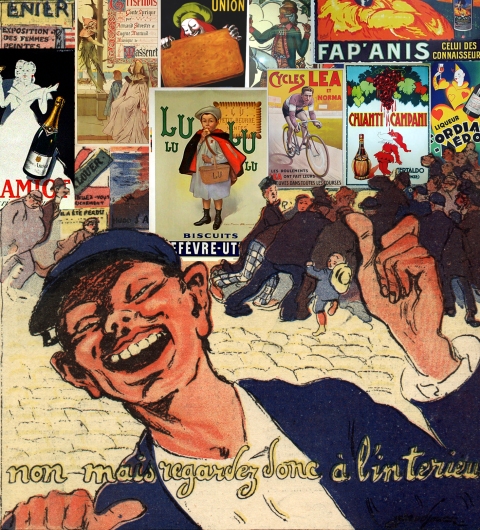
It is always a treat to find references to the ubiquity of posters in paintings. Attending museum exhibits which focus on the past 150 years often include both advertising posters from the period as well as art with life on city streets as it’s subject. If the viewer is attuned to posters, they can be spotted in some of these paintings and photographs.
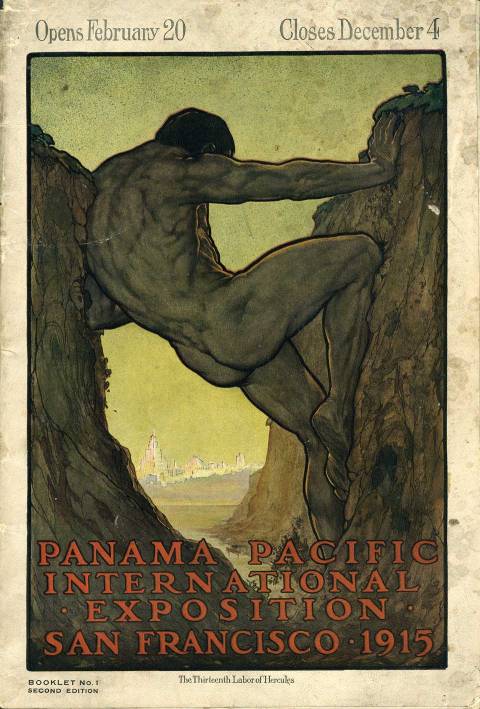
Panama Pacific International Exposition Poster (via Emphemerastudies.org)
In the current show at the DeYoung, the obvious poster is the one advertising the fair itself. As is the case with most world’s fair posters, they artist won a poster competition and their design was selected by a committee to advertise the Fair.
The winning design was by Perham Nahl and features the son of Jupiter parting the earth to reveal San Francisco in the background. The poster is quite small- measuring 13 3/8″ x 24″ and the color palette is subtle.
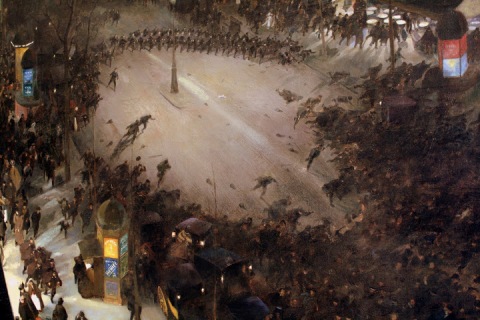
Andre Devambez – La Charge (1902) (via artandopinion.tumblr.com)
The poster within a painting which really struck me though was “The Charge” by Andre Eduoard Devambez. This painting, which is on loan from the Musee D’Orsay is apparently the most famous work by the artist. It features a street scence in Montmarte- a conflict between demonstrators and police, and is painted with an unusual perspective- as if viewed by the painter from above the scene. I was struck by the fact that the street in the scene was dotted with poster kiosks on both sides of the street, and that they serve to punctuate the street. And then I realized the artist’s name was Devambez. Possibly this was a coincidence, but the last name is also that of one of the very famous poster printers, which we have catalogued on numerous occasions. The placard at the DeYoung mentions that Devambez’s family printed the catalogue of French art on view in the French Pavilion at the Exposition. So my hunch that this artist would be from the very same family who printed the legendary posters of Leonetto Cappiello among others grew stronger.
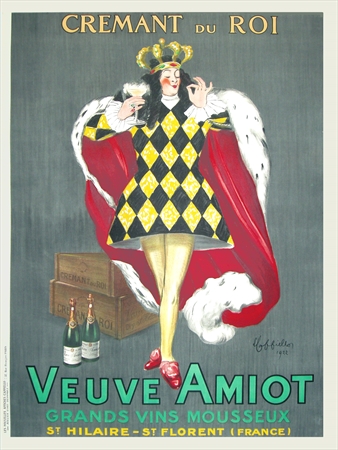
Veuve Amiot by Leonetto Cappiello 1922 (via vepca.com)
It turns out that the Devambez printing house was established long before the hey day of Cappiello. Eduoard Devambez was himself an artist, and his print house was highly respected for it’s work with engraving, copper plate etching, typography, lithography, calligraphy, book binding, stamping and won awards at world’s fairs. Devambez was awarded the prestigious work of printing presentation books, menus for visiting foreign monarchs and became the official engraver for the Royal family of Portugal.
It is Eduard Devambez’s son who created “The Charge” in 1902. While I was studying the painting at the DeYoung, a docent led tour came into the gallery, and we learned about how the paintings for the French Pavilion at the Pan Pacific made their harrowing journey to San Francisco.
Of course a worlds’s fair- like an Olympics- is planned for by its host city and by participants for years ahead of the actual event. The art slated for display at the French Pavilion had already been discussed, when war broke out on July 28, 1914.
Much of World War I was fought on the open ocean, so transporting goods across the Atlantic was tricky. Munitions and supplies were the priority, and those shipments were targets. France was eager to keep its word to display art at the Pan Pacific Exposition, and to show the superiority of their artists. This, coupled with the fact that many precious artworks in French museums were being crated up and hidden from possible theft, made sending the works oversea an even greater imperative.
So how was it done? The allies made use of what was called the Christmas Ship. This ship was packed with clothing, toys and food donated by American children and intended for British and Belgian children as a goodwill gesture. The ship was unloaded at a number of ports in Europe. Amid great secrecy, the Christmas Ship was loaded with precious works of art destined for the 1915 Pan Paciifc Worlds Fair in San Francisco. Because of the opening of the Panama Canal, the journey was shortened by 8,000 miles.
This blog post was written by Elizabeth Norris, principal of Vintage European Posters. Please visit the Vintage European Posters website www.vepca.com to view our extensive collection of original advertising posters.
Our showroom at 2201 Fourth Street is open
Tuesday- Sunday for the 2015 Holiday Season.
(closed on Thanksgiving)
Shop Hours 11-6 Saturdays
11-5 other days
August 27th, 1916: Italy Declares War on Germany
August 27, 2014 § Leave a comment
August 27th, 1916: Almost one hundred years ago today, Italy declared war on Germany despite its policy of neutrality during World War One. In 1915, a year before this declaration of war, Italy agreed to the terms of the Treaty of London which secured large tracts of land to Italy. The Triple Entente (Britain, France, and Russia) wanted to weaken the Central Powers (Germany, Austria-Hungary, Ottoman Empire, and Bulgaria) by opening up a southern front and they believed the Treaty of London would persuade Italy to fight on their side. They were correct with this prediction.
Unfortunately, Italy didn’t exactly achieve a great military success. Italy, weary after the victorious Italo-Turkish War of 1911, entered WWI a mere five years later and suffered a crippling defeat at Caporetto against an Austro-Hungarian army, losing 300,00 men. On top of this humiliation, Italy was snubbed at the conclusion of the war with the Treaty of Versailles and its exclusive negotiations.
Above is Orth’s “Banco di Roma,” a poster encouraging Italians to subscribe to the 1920 National French Treasury Loan. The female on the right is Marianne, a national symbol of the French Republic, signifying liberty and reason. She reaches towards the Colosseum, showing the political alliance of France and Italy. The text beneath her translates to “It is the ashes of death which creates the homeland.” This quote is by the French poet and politician Alphonse Lamartine, who helped found the French Second Republic and was known as a spokesman of the working class. In an effort to pay for war debt and rebuild Europe, Orth sends a message of rebirth after destruction and the power of collaboration.
Check out our upcoming show titled “A Call to Action; Posters of the First World War” which includes over 100 original World War I propaganda posters. The Show will run from September 13- September 23rd at our gallery at 2201 Fourth Street, in Berkeley, CA.
This post was written by Nicole Garson, Intern, UCB class of 2016 and edited by Elizabeth Norris, Proprietor of Vintage European Posters
Our Shop is Open Tuesdays-Thursdays from 11-5 and select weekends.
2201 Fourth Street, Berkeley Corner of Allston Way
Please call 510 843 2201 or email vintage posters@vepca.com to confirm hours.
Visit our collection on the web at vepca.com














